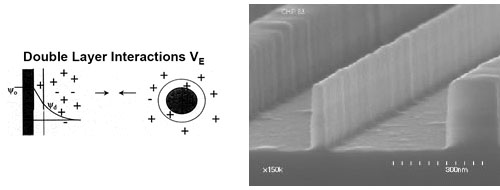Electro Scrub
Electroscrub Chemicals
Model:
Electro Scrub Technology. Inc is a chemical company producing unique solutions intended for the advanced IC industry. Electro Scrub Technology. Inc products are not a mere variation on existing products, but are entirely new solutions for problems facing the semiconductor industry. There are no analogues to Electro Scrub Technology. Inc products in the marketplace. Electro Scrub Technology. Inc does not have a broad line of products, but only has products to address the most pressing problems that the semiconductor industry is facing and for which no other product offers a solution.
Electro Scrub Technology. Inc addresses among others, such challenging processing steps as the bottom contact hole etch and clean, an improved particle removal process without aggressive mechanical forces, edge bead removal that not only removes the edge bead photoresist, but also cleans the edge from particles and photoresist stripping for the mask industry.
Electro Scrub Technology. Inc addresses among others, such challenging processing steps as the bottom contact hole etch and clean, an improved particle removal process without aggressive mechanical forces, edge bead removal that not only removes the edge bead photoresist, but also cleans the edge from particles and photoresist stripping for the mask industry.

| Conventional diluted HF or buffered HF as used for the bottom contact hole etch and clean expands the CD of the sidewalls unevenly, since the etch rate of various oxides varies quite substantially depending on the specific oxide. The Buffered OrganoEtch1 can etch the bottom oxide and clean the contact hole without expanding the contact hole CD unevenly. |
| DRAM Stacked Capacitor Etchant |
| Conventional diluted HF or buffered HF usually leaving leads to sticking of adjacent capacitor structures and leaves watermarks and/or particles. These problems can be solved with the SASIC OrganoEtch1. This solution is capable of removing unwanted SiO2 with its low surface tension without leaving behind any watermarks or particles. The surface can be dried without any need for DI-Water rinsing. All constituents in SASIC OrganoEtch1 are volatile. |
| Edge Bead Remover |
| Conventional Edge Bead removers such as PGMEA and Ethyl Lactate can remove the Edge Bead photoresist very well. However, none of the conventional Edge Bead Removers are capable of removing particles from the bevel edge. This is a very important issue in immersion lithography since any remaining particles on the edge can be transferred to the active area of the wafer and contributes to low yield. The SASIC OrganoStrip 1 (EBR1) not only can remove the photoresist, similar to conventional Edge Bead Removers, but it can also remove particles from the edge. |
| CMOS Imager Cleaning |
| 1- In CMOS imager cleaning, devices are required to be completely clean, free of any watermarks and particles after rinsing with DI-water. The SASIC OrganoClean, such as OrganoStrip 1 (EBR1), can solve these problems without a need for DI-water rinse. 2- The SASIC OrganoClean is one of the only organic solutions that work with Megasonic. This solution can remove all particles with a Megasonic power as low as 100W. |
| Photomask Cleaner |
| The conventional Photomask cleaner such as hot concentrated sulfuric acid and SC1 Process (mixture of ammonium hydroxide and hydrogen peroxide) create haze on the surface of Photomask. This serious problem significantly decreases the production yield. The SASIC Photomask cleaner (Barracuda Series) is a practical solution to this problem. The SASIC Barracuda is a Non-Sulfate product capable of stripping photoresist and BARC layers on Photomask in less than 5 minutes without leaving any haze on the surface of Photomask |
| Wet Particle Clean Solutions |
| Currently, the patterns on the wafer are becoming so small, that they are extremely fragile and conventional particle removal methods based on applying mechanical forces such as Megasonic or high pressure aerosol spray cannot be used any more, since they damage such fragile patterns. The SASIC particle remover (ElectroScrub Series) is a chemical solution to particle removal that does not damage such fragile patterns. |
| Wet Clean Particle Remover, an advanced particle and defect removal solution where particles can be removed even without applying mechanical force |
| The ElectroScrub solutions have a strong capability to remove particles. The ElectroScrub solutions can be classified into two different classes: ElectroScrub1, and ElectroScrub2. 1 - ElectroScrub1 with pH of about 9-10, is used for cleaning a wide variety of surfaces. 2 - ElectroScrub2 series is based on the ElectroScrub1. In the Electroscrub2 a cleaning abrasive agent has been added. This cleaning agent can remove particles from the surface of wafers with the help of abrasives inside of solution. The ElectroScrub series of particle removal solutions is based on a novel approach to amplify the electrostatic forces, which remove particles from the surface of the wafer. Originally developed for the Hard Drive Industry, where particle requirements are very tight, these solutions were so successful that they are being introduced in the semiconductor industry as well. (1) The Electroscrub1 basic is the original particle removal solution and has a pH after dilution of about pH 9.5. (2)The Electroscrub2 is a version where in addition to Electroscrub1 a mild abrasive is added for improved particle removal. (3) On top of these 2 basic versions, there are also variations, which have a modified pH value from the basic versions. Standard pH values (after dilution) that are available are: 12 and 14. Custom pH values can be synthesized. |